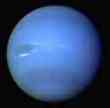Solar System -
Neptune
Although Galileo had observed it in 1612 and 1613, he did not record it as a planet but as another star. Based on observations of Uranus motions, Urbain Joseph Le Verrier calculated where he believed another planet should orbit, and also calculated its mass. Johann Gottfried Galle of the Berlin Observatory found it in 1846 from Le Verrier's calculations. Of the eight planets, Neptune is the only one not visible to the naked eye as it is almost 4.5 billion km (2.8 billion miles) from the Sun, which it orbits about once every 165 Earth years. This is about 30 times further away from the sun than is the Earth. A "day" on Neptune is just over 16 hours long.
Neptune is four times larger than the Earth with an equatorial diameter of around 49,500 km (30,775 miles). It is much less dense than the Earth, weighing only 17 times as much, and has a very strong magnetic field.
Neptune is bright blue in color due to the frozen methane in its atmosphere; similar to Uranus, but a much brighter blue. Below this there is a darker cloud layer that is probably hydrogen sulfide. Most of the planet comprises gas and liquefied gasses, but it has a solid core that is believed to weigh about 1.2 times the mass of the Earth. The temperature at the core is probably around 5,400K, which is almost as hot as the surface of the Sun.
The winds on Neptune are the strongest of any planet in the Solar System. There appear to be giant storms, comparable in size to the Earth, that travel through the atmosphere at speeds of approximately 1,200 km (750 miles) per hour. They are not as long lived as the Great Red Spot on Jupiter, but do persist for several months.
Neptune is four times larger than the Earth with an equatorial diameter of around 49,500 km (30,775 miles). It is much less dense than the Earth, weighing only 17 times as much, and has a very strong magnetic field.
Neptune is bright blue in color due to the frozen methane in its atmosphere; similar to Uranus, but a much brighter blue. Below this there is a darker cloud layer that is probably hydrogen sulfide. Most of the planet comprises gas and liquefied gasses, but it has a solid core that is believed to weigh about 1.2 times the mass of the Earth. The temperature at the core is probably around 5,400K, which is almost as hot as the surface of the Sun.
The winds on Neptune are the strongest of any planet in the Solar System. There appear to be giant storms, comparable in size to the Earth, that travel through the atmosphere at speeds of approximately 1,200 km (750 miles) per hour. They are not as long lived as the Great Red Spot on Jupiter, but do persist for several months.
Description
Neptune's composition is very similar to Uranus. The atmosphere consists mainly of hydrogen, methane, and helium. Below it is a layer of liquid hydrogen including helium and methane. The lower layer, the Mantle, is liquid hydrogen compounds, oxygen, and nitrogen. The planet's core is believed to comprise rock and ice.
Credit: NASA
Credit: NASA
Photograph taken in 1989 by Voyager 2. The large dark oval to the west (left side) circled around Neptune every 18.3 hours. The bright clouds immediately to the south and east of this oval change their appearances substantially in periods as short as four hours. The second, smaller and fainter dark spot, to the lower right, circled Neptune every 16.1 hours. Virtually all we know about Neptune comes from the Voyager 2 fly-by in 1989.
Credit: NASA/JPL/Voyager 2
Credit: NASA/JPL/Voyager 2
This image shows three prominant surface features. The Great Dark Spot at the top, the white cloud in the middle that was nicknamed Scooter and the Small Dark Spot at the bottom. To the right is a close up of the Great Dark Spot.
Credit: NASA/Voyager 2 Team
Credit: NASA/Voyager 2 Team





